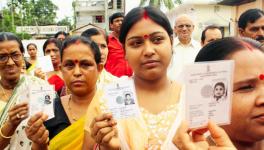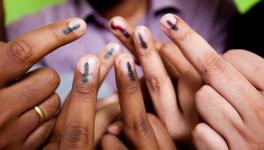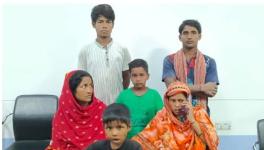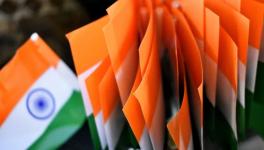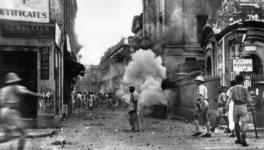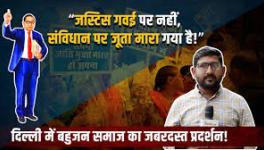Scattered Chapatis, Mangled Bodies: Semiology for a Nation

Images are instrumental in evoking nationalist drives, but there are structured gradations of images. Images of military helicopters scattering rose petals over Covid-19 hospitals, or of naval ships firing at ocean waves—in a demonstration of national solidarity and gratitude towards “corona warriors”—will fire up adrenalin and invoke a highly-trumpeted nationalistic fervour. On the other hand, images of scattered chapatis and bodies of migrant workers run over by a goods train, or smashed by a truck, will at best generate a short-lived emotive response—sympathy—and at worst provoke outrage or a sense of discomfort that we would prefer to evade.
The bodies of the poor make for disturbing images that demand attention, but only to be exiled into an evasive oblivion. We do not brood over those images—we are scandalised by them. They are characterised by a hauntology that borders on discomforting self-scrutiny. On the contrary, images that spill over, or open out with an excess of splendour, have a transfigurative appeal of cosmetic bliss. In other words, they entice and invite us to participate in a glorious spree of make-believe. This is what constitutes, in our contemporary nationalist politics, what pundits call “the battle of perceptions”.
It is possible that the hyperreal has surpassed the real today, because the former delusionally invests the perceiver with a surplus of pomp. We fetishise the image, gluttonise on decked-up spectacles and participate in splurges of colour and gloss. Quite naturally, therefore, we tend to demolish any sign-system that overdoses on the elegiac. To push the frame a bit further—the poor do not make good images when dead; their corpses fail to evoke nationalist fervour. To eviscerate this deficiency the poor have to at least be draped in a soldier’s uniform, if not the national flag. That way, the bodies of the poor can be glossed over in a surfeit of nationalist symbols.
What makes a nation then: men, women, children? Or signs and symbols?
The economy of life appears to be inscribed in the symbolic chains of images and their meanings, not just on grinding issues of life and death. A migrant worker has manual values, but a soldier, along with that manual military worth, also possesses the surplus value of being a “national warrior”. Doctors and nurses are “corona warriors” and there can be little debate on that, but lost in that acknowledgement are the unsung stories of the numerous poor workers who have become cannon fodder in this “national battle against the pandemic”.
Like cannon fodder, the migrant worker is expendable. Their bodies are not covered in the Tricolour, no guns are fired for them, there are no garlands for them; only some tears and television coverage, but they too dry up as the festival of glossy images unfurls. If one needs to inquire into the malaise of Indian nationalism in recent years, it needs to begin from here. Perhaps Marx could not foresee the power of semiotics, or he would have dwelled on semiotic capital just as much. For, there is not just an ideologically-reified false consciousness, but a libidinal and psychic economy of images as well. This libidinal investment in visual power obfuscates all other considerations in a matter of minutes. This economy gives those images of scattered chapatis and bodies on the railway tracks or of migrant workers walking home, unfed and untreated, zero nationalist appeal.
What probably differentiates the Indian response to the Covid-19 crisis from that of other countries is the simultaneous tragedy of pandemic deaths along with the the unfortunate deaths of migrant workers as they trudge home. Seen hermeneutically, the uppermost question that arises is, why do those images of dead workers fail to generate a national uproar beyond the manageable emotive moaning that—our politicians know—never amounts to full-scale dissent?
Thali nationalism, Diwali solidarity and dispensable workers:
That the government was blissfully unaware of, or perhaps deliberately ignored, the unfolding agony of the migrant workers testifies how their plight is viewed as an electoral non-issue. To deflect attention from its unpreparedness for the suddenly-announced lockdown and its own lackadaisical attitude, the political class mobilised (and therefore de-politicised) the people with thali-banging and mini-Diwalis. The pliant media toed the government’s line to cultivate the image of a warrior-like nationalist leader who is fighting Covid-19 with bravado. The media also went berserk to ‘Otherise’ and enemy-ise the Muslim community over the markaz incident.
It is amidst this cacophony, however, that the images of distressed migrant workers, generally buried in the political unconscious, came to haunt the mediascape.
Two images and the contrasting responses they evoked from Indians deserve mention here. The first is the tragic image of dishevelled bodies of paramilitary soldiers who were killed in a brutal terror attack on 4 February 2019 in Pulwama. Politically, this was used as a 9/11 type of “spectacle of hurt”, justifying “swift revenge” (to use a George W Bush phrase). The whole country, riding on burgeoning nationalist emotion generated by the tragic images of the incident in Pulwama, was virtually up in arms.
There were reports from across the country of attacks on those who tried to ask difficult questions about the timing of the attack or the alleged intelligence and security lapses that may have allowed such an attack to occur. That such an event and related images can generate a countrywide response of “national hurt” was testified by the subsequent electoral consequence.
The second image is of the scattered chapatis and mangled bodies of sixteen migrant workers on the railway tracks near Aurangabad. The visual stimulus generated by images of this incident range from an anguished click on the “feeling sorry” emoticon on social media platforms to sharing the images of the incident.
It is true that a terror attack was not instrumental in the loss of life of those workers. The analogy between the two images does not stand in that sense. That said, we tend to problematise the distinction between the unfortunate and unacceptable soldier deaths and the death of poor workers because of collective apathy and governmental uncaring. Does our oblivion and subdued anger on these migrant deaths amount to a form of social terror?
The semiotic grammar of nationalist imageries is sustained by a hierarchy of image-values. A hyper-signification is attached to certain images, while images of poor dead bodies draw flak. The death of poor workers makes newspaper headlines, but does not reconfigure national headlines. Walking bodies, desperate bodies, agonised bodies, hunger-torn bodies, register their semiotic inadequacy in terms of national emotion.
The prerequisite for the perfect national image is that it needs an enemy, even a fictionalised ethnic enemy or one across the border. Poverty and death of the poor certainly do not count as the acts of a national enemy.
Compassion-fatigue or compassion-deficit?
An image, to use Roland Barthes’ proposition on photography, is the collective memory of the world. The myth-making potential of the image has huge political ramifications. Images can lead to perspective changes and generate unprecedented political responses. The images of the torture of Iraqis by American soldiers or the more recent ones, of the toddler Aylan Kurdi, floating dead off Italy’s shores, changed the responses of European countries towards the refugee crisis.
However, images of distress often also fail to draw attention and seek redress because of a phenomenon that Susan D Moeller, who teaches media and international affairs in the Philip Merrill College of Journalism at the University of Maryland, calls “compassion fatigue”. In her book, Compassion Fatigue: How the Media Sell Disease, Famine, War and Death, Moeller says that compassion fatigue can result from “short attention span”, lack of publicity to an event, the boredom that sets in due to the media’s serialised coverage of crisis, the sameness of catastrophes, longevity of a crisis, the sheer number of crises occurring simultaneously and other factors.
But is compassion fatigue the reason why images of dead migrant workers and their desperation failed to generate a lingering sense of social outrage in India? Are people bored by the unending Covid-19 “crisis” or is there a deeper malaise of nationalism, which has exiled such images as non-issues?
Perhaps a better phrase to describe the current situation in India would be compassion absence, not fatigue. After all, the longevity and enormity of the pandemic did not prevent us to take part in thali-banging or lighting lamps. That the middle class can be mobilised when it affects their own interest is proven on numerous occasions. The middle class that grew since economic liberalisation and thrived on the liberal ethos of competitive individualism and compulsive consumption suffers from compassion deficit and ignores the crisis of the poor, whose images lie buried underneath the semiology of consumption.
The images of lakhs of migrant workers—haggard, hungry, desperate—have brought to the surface poverty and material want, which had virtually been erased under a dazzling grammar of photo-op nationalism. Can we seize the image of the scattered chapatis for an alternative politics that caters to the needs of the people? The French Revolution started with the demand for bread to the people!
Anindya Sekhar Purakayastha is a professor at the department of English, Kazi Nazrul University, West Bengal and Mursed Alam is assistant professor, department of English, Gour College, University of Gour Banga, West Bengal. The views are personal.
Get the latest reports & analysis with people's perspective on Protests, movements & deep analytical videos, discussions of the current affairs in your Telegram app. Subscribe to NewsClick's Telegram channel & get Real-Time updates on stories, as they get published on our website.










